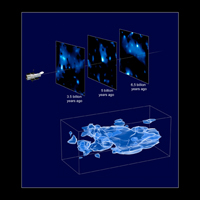What is gravitational lensing?
It is commonly taught that in a vacuum light always travels in straight lines. While this is the case for many situations on Earth, when we look out into the Universe, the situation is more complex. Einstein's General Relativity describes gravity as curvature or warp in the fabric of spacetime. Massive objects therefore create their gravitational fields by warping the spacetime continuum. Light rays travel through the Universe on paths called geodesics, which are in essence the shortest distance between two points in a curved space.
In a flat plane, such as the almost constant gravitational field near the Earth's surface, the geodesics are essentially straight. In the wider Universe, however, this is not the case. On curved surfaces, such as the warped spacetime of the large-scale Universe, the geodesics are curved.
Because of this, it is most likely that every ray of light we detect has been deflected to some small degree as it travels through space. This is caused by the gravity of the various galaxies and clusters of galaxies that a light ray passes on its journey.
Known as gravitational lensing, this extraordinary property of nature was predicted to exist by Albert Einstein's General Theory of Relativity in the early 20th century. The mathematics showed that any massive celestial object can bend passing light rays in the same way that a glass lens bends light in a telescope or microscope. However, the amount of deflection was tiny and would need special conditions to be met in order for telescopes to detect it.
In 1919, those conditions were met by the occurrence of a total solar eclipse in a rich star field. Expeditions led by British astrophysicist Arthur Eddington were dispatched. During the moment of eclipse, the astronomers observed deflections in the starlight that had been caused by the Sun's gravitational field. When they compared their results to Einstein's predictions, they found that they matched. This result played a key role in the experimental proof of Einstein's theory.
Einstein's notebooks indicate that about seven years earlier, he had realised that if an observer was located at the correct distance, the deflected light rays from around the celestial object would converge to make a magnified image. This is a phenomenon known as a strong gravitational lens. For example, to use the Sun as a gravitational lens to form an image of a more distant celestial object, an observer would have to be at least 550 times further away from the Sun than the Earth.
In a weak gravitational lens, light rays are not deflected enough to magnify the image, instead they introduce subtle distortions. Although the deflection from each cluster of galaxies is virtually undetectable on its own, the cumulative effect imparts a subtle distortion on the images of distant galaxies that can just be inferred from measurements. Astronomers refer to this effect as cosmic shear.
Since its first detection in 2000, cosmic shear has evolved into a reliable and robust cosmological probe, providing measurements of the expansion history of the Universe and the growth of its structure. It has provided constraints on the density of matter in the Universe, the amount of galaxy clustering in the Universe, and the behaviour of dark energy. All three have been close to the theoretical expectations from measurements of the cosmic microwave background radiation, and this has increased confidence in the technique.
 |
| Illustration of weak gravitational lensing. Credit: NASA, ESA, and R. Massey. |
In the case of weak lensing, the lens itself is an extended distribution of dark matter in front of a dense background of galaxies. Due to the dark matter's gravitational field, each background galaxy is very slightly distorted. The distortions of the background galaxies are not random but will align with the density distribution of the dark matter. Thus, examining the background galaxies together will reveal a shear image of the foreground structure.
By measuring the redshift to each background galaxy, it becomes possible to disentangle the dark matter structures that are located at different redshifts. With a sufficient amount of background galaxies at different redshifts we can perform tomography of the dark matter structures. Euclid will do this by measuring the distortions of 1.5 billion background galaxies, stretching across 10 billion light years of the Universe, to create a three dimensional view of the dark matter distribution of our Universe.
With this information, cosmologists will be able to deduce the way that the large-scale distribution of galactic structures has built up throughout cosmic history. This will help them determine the speed at which such structures grow. As a result, it will provide strong constraints on the nature and amount of dark matter and dark energy in the Universe, which both affect the growth rate.
| Read more |
| 1: Mission science |
| 2: What is dark matter? |
| 3: What is dark energy? |
| 4: What is gravitational lensing? |
| 5: What are baryonic acoustic oscillations? |
| 6: Legacy science (beyond cosmology) |

